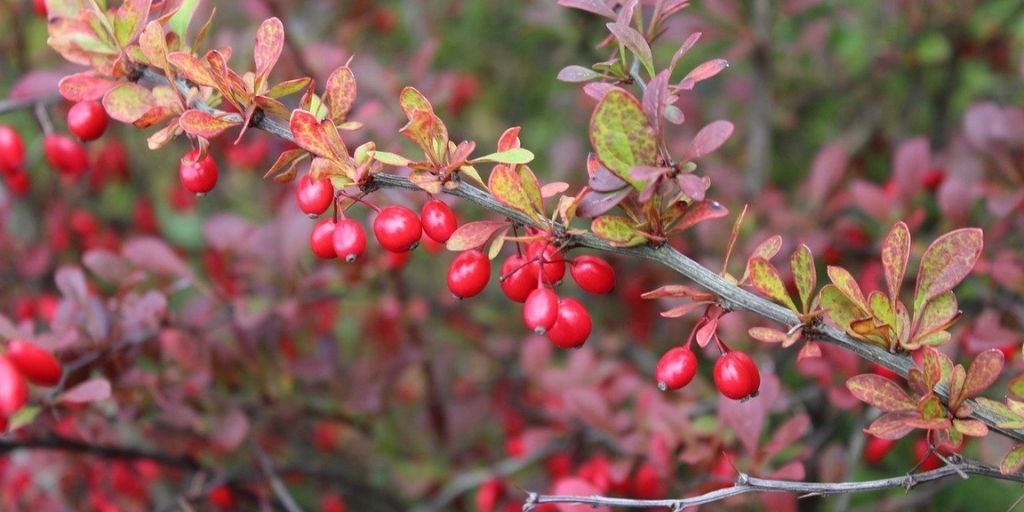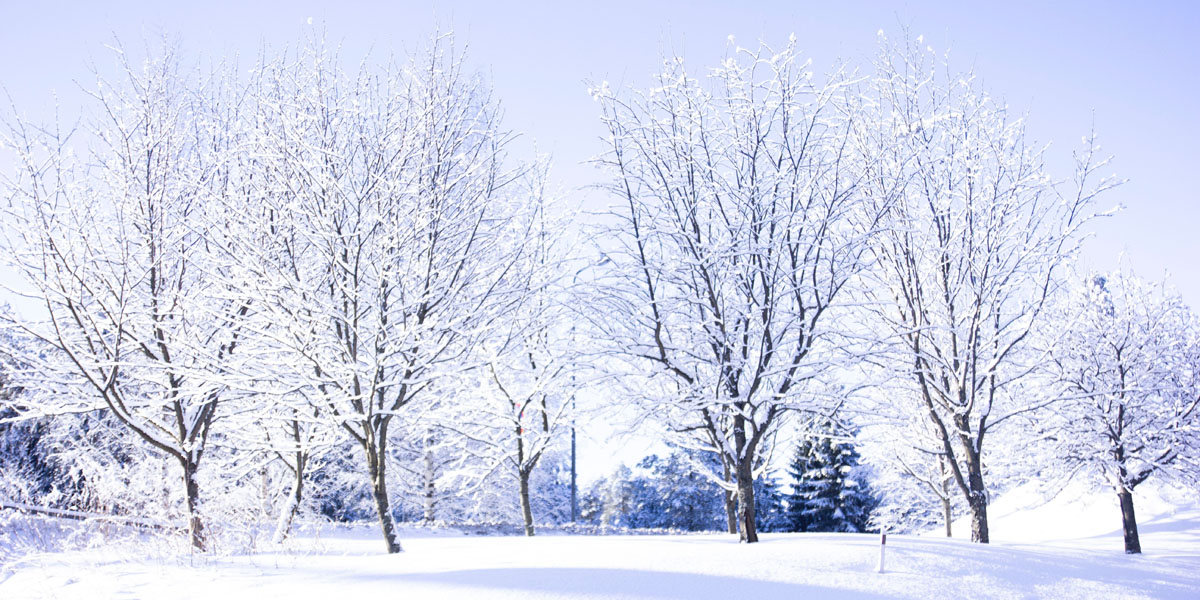In New Jersey, it seems like deer are everywhere – and they are. Hungry deer will eventually find any garden that’s full of tasty plant species (including shrubs and trees) and not enclosed by a deer fence. If you’ve ever woken up one morning to see that your garden has been given a severe haircut or that some plants have disappeared, you know the kind of damage browsing deer can inflict.
In winter, when food sources are scarce, the problem becomes worse. Deer are emboldened by hunger and will expand their usual range, even into urban environments where they’re rarely (if ever) seen at other times of the year.
If you want to keep your garden from becoming a snack bar, read on to learn what you can do to protect your prized plants from these doe-eyed destroyers. We cover a wide range of options to save your trees, shrubs, and plants from deer browsing.

A white-tailed deer is barely visible behind trees and shrubs, which are a source of food during the fall and winter months
Why are there so many deer in New Jersey?
You’ll find white-tailed deer in urban, suburban, and rural settings in New Jersey. Wherever farmers or gardeners have planted attractive crops or plants, deer will try to browse.
Why are there so many deer? The answer is complex.
Deer are neither good nor bad, although people classify them in one of these categories. The complex topic of deer in New Jersey includes paradoxes with no easy solutions.
| ”Good” | ”Bad” |
|---|---|
| Deer are food for hunting animals like wolves and cougars | Human activity and development have lowered these predator populations, causing deer populations to expand |
| Deer eat native plants and spread those plant seeds when they poop, ensuring plant diversity and increasing the range of native plants | Deer are somewhat indiscriminate feeders; they eat (and spread) prized garden plants and potentially invasive species from all over the globe |
| Deer are valued game and trophy animals | Hunters often prefer antlered male deer to the does; that keeps population levels up. Plus, hunting seasons are regulated |
| Deer roam (and prefer) forested areas where few if any, people live | Farms and suburban development are found near forests or have reduced the area of existing forest habitat; deer have no choice but to leave their preferred forested environments in search of food |
| Deer are browsers | Garden plants and farm crops offer ideal browsing; it’s a deer smorgasbord! |
And so on. Conflicts are bound to occur whenever we have an overabundance of deer combined with residential development in once-forested areas.
While we could focus on the why’s of deer populations, we’d rather give you information on how to protect your garden from deer damage.
Prevent Deer From Eating Your Plants
It feels like deer eat everything, but there are plants that they will pass over when other options are available. While few plants can be guaranteed deer-proof, there are plenty that are naturally less appealing.
From pine trees to ornamental grasses, you can select plants that will make your garden attractive to you and less so to deer.

Barberry shrubs provide autumn color to your property and are deer resistant
Plants That Deer Don’t Like
Although deer will eat almost anything if they’re hungry enough, there are some familiar garden plant species that deer are less likely to eat. Planting these, particularly around the perimeter of your property, will make your yard less appealing to deer.
- Birches (Betula species)
- Pines (Pinus)
- Holly (Ilex)
- Bayberry (Myrica pennsylvanica)
- Bearberry (Arctostaphylos uva-ursi)
- Butterfly bush (Buddleia)
- False indigo (Baptisia)
- Feather reed grass (Calamagrostis)
- Russian sage (Perovskia)
There are many other species that are rarely or occasionally damaged by deer. On the other hand, there are many species that are almost always browsed by deer. Check this landscape species list from Rutgers University that is broken down by the likelihood that deer will browse or damage them.
Both a plant-loving home gardener and a professional landscape designer can make beautiful garden designs using the plant species that are least appetizing to browsing deer. And a bonus is that many species that deer don’t head for first are plants that also attract pollinators, offer wildlife habitat, and are native to our area.
How to Keep Deer Away From Your Plants
While deer damage could drive you from your home, most people don’t have the option to move away if their home is near deer habitat such as forests, woodlands, and farms. If deer often browse through your garden’s offerings, there are several methods you can use to significantly reduce deer damage. These include barriers and repellents.
Install Deer Fencing
Good fences make good neighbors, wrote Robert Frost. While he wasn’t talking about deer, good fences can make better neighbors of deer by keeping them minding their own business outside of your garden.
A good deer fence is a tall fence and surrounds your entire property (or at least the area you want to keep deer out of). The standard height for deer fencing is eight feet (8’). Fence panels are often made of galvanized wire mesh, sometimes with a black polypropylene coating. This black coating helps the fence be less visible to human viewers. Experts recommend that new deer fences include some fluttering, reflective, or bright-colored tape or fabric to warn deer that might otherwise run into the unfamiliar fence and injure themselves.
For more details on deer fencing, Rutgers has information available on long-lasting wildlife fences that can keep deer out.
Note: New Jersey municipalities may have restrictions or regulations on where and how deer fences can be built. Check your local codes before starting to build.

Damage to hosta plants by grazing deer.
By User: SB_Johnny – Own work, CC BY-SA 3.0, https://commons.wikimedia.org/w/index.php?curid=1352747
Protect Individual Plants
The simplest way to keep deer away is to plant trees and shrubs that deer don’t like (see above). But if you have plants that deer do like and cannot install permanent deer fencing, try protecting individual plants (or groups of plants) instead. Enclose your vegetable garden, fruit trees, or special plants with a wire mesh fence or cage. Be sure it’s firmly anchored so curious deer (or pets!) can’t knock it over.
In winter, many evergreens are wrapped in burlap to protect them from weather damage. These wraps will also protect the plants from deer browsing. The same is true for wire coverings that keep bark from being gnawed or damaged during the deer rutting season.
Use Deer Repellents
Deer repellents are often used to keep deer away from tasty foliage. These can be motion-activated sensors that spray water, electric fences that shock deer, or sprays. Just don’t use noise- or light-emitting repellent devices where neighbors will be bothered by the sound or light!
Before investing in expensive repellents (there are many sold online), do a little research to find out if deer can become accustomed to the sights, sounds, and even electric currents that these devices emit. Deer can become desensitized to things that once frightened them, particularly if they’re rewarded with a tasty treat.
Deer Spray Repellents
Spray repellents are designed to repel deer with unpleasant odors or tastes.
Please don’t use chemical repellents that contain toxic ingredients, such as nicotine, ammonia, or mothballs; they’ll harm the environment more than the deer. Sprays made from predator urine are popular but pose ethical concerns for some homeowners. Whatever option you choose to use, we recommend finding reliable source information on the ingredients and effectiveness of these sprays.
Non-toxic sprays use substances that are aversive to deer, such as hot pepper, garlic, peppermint oil, or rotten eggs (the smell of rotten eggs is also aversive to many people!). These sprays need to be regularly re-applied to maintain their potency, and some shouldn’t be used on edible crops. In winter, non-toxic deer repellent sprays can be diluted by rain or snowfall, so keep an eye on the weather and reapply sprays as needed when winter temperatures are above freezing.
Other Deer Repellents
Strongly-scented soap is often recommended to deter deer. It can be hung from branches, tied to a stake, or placed in a mesh bag near plants that deer like. Be careful not to place soap where it can coat nearby plants as it dissolves (a good rainfall can cause suds to run down anything the bar of soap is attached to).
Also, know that soap can be attractive to rodents so don’t put it where they can easily reach it. You don’t want to solve one problem by making another!
Just as the reasons for deer overpopulation are complex, so are the methods for deterring them. If you can’t enclose your entire garden with a deer fence, you may need to experiment with different deterrent methods to find ones that keep browsing deer away from your valuable plants. An online search will give you countless suggestions for how to make deer repellent sprays and how to hang soap, bags of human hair, or other odor deterrents from the branches of trees and shrubs.
In Summary
Neither people nor deers are going anywhere soon, so we have to learn to live together. For humans, this means making changes to how we design our gardens, understanding the complexities of the natural world, and taking a more philosophical approach to occasional deer browsing.





